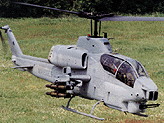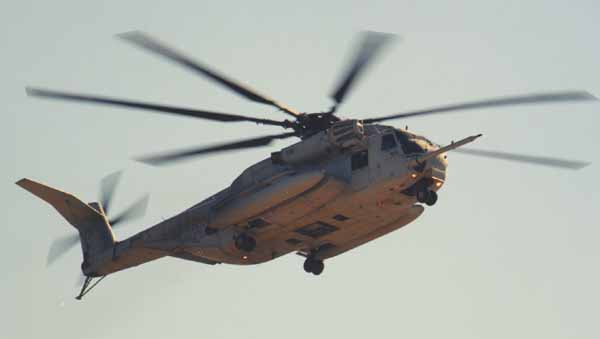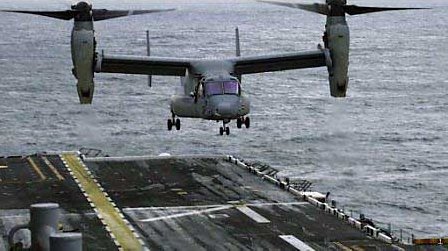Sunday
August 27, 2000 :
Marines Ground 3 Types of Aircraft
WASHINGTON, USA ( AP, By Robert Burns ) -
The Marine Corps announced Sunday the temporary grounding of all 11 of its MV-22 Osprey tilt-rotor aircraft, the hybrid airplane-helicopter that has been under increased scrutiny since one crashed during a training exercise in April, killing all 19 Marines aboard.

|
The decision to suspend Osprey flight operations was made late Friday by the Naval Aviation Systems Command, which also ordered the Marines to temporarily ground its fleet of CH-53E Super Stallion transport helicopters and AH-1W Cobra attack helicopters , spokesman Lt. David Nevers said.

|
Nevers said the most significant of the three actions was the grounding of the workhorse CH-53E Super Stallions, because it is likely to take longer to get them back in the air than either the Ospreys or the Cobras.
Nonetheless, the Osprey's problem is likely to draw the most public attention, in part because of recollections of the April crash - the worst Marine helicopter loss in more than a decade - and in part because some members of Congress have criticized the Osprey program as too expensive and technically flawed.

The Osprey takes off and lands like a helicopter but flies like an airplane. It is built by Boeing Co. and Bell Helicopter Textron.
The Osprey fleet was taken out of operation for about two months after the April crash in Arizona. Investigators determined the crash was caused by mistakes made by the pilot and co-pilot, not a mechanical problem. The Ospreys resumed flying in June.
Last Thursday, an Osprey made a precautionary landing at Camp Lejeune, N.C., and a subsequent maintenance inspection revealed that a coupling on the aircraft's drive shaft had failed. The coupling was repaired and the Osprey returned to its home base at Marine Corps Air Station New River, N.C.
``In the interests of safety, they will check the other aircraft's couplings'' before returning them to flight, Nevers said. He said he could not estimate how long they would be out of operation.
The Marines are counting on the Osprey to eventually replace the corps' Vietnam-era CH-46 helicopters as the primary means of transporting troops into combat from ships offshore. The Marines plan to buy 360 Ospreys, and the Air Force plans to buy 50 for its special operations forces. The Defense Department has not yet made a final decision to enter full-rate production of the Osprey.
The decision to ground three types of Marine Corps aircraft, albeit for unrelated reasons, puts an unusually large portion of the Marine aviation fleet out of operation. In July, 106 of the Marines' AV-8B Harrier fighter jets were grounded because of an engine bearing problem. Thirty of the Harriers have since returned to flight, but that leaves the majority of the fighters still grounded.
The decision to ground all 165 of the Marines' CH-53E Super Stallions was based on findings from the investigation into the Aug. 10 crash of a Navy MH-53E mine-sweeping helicopter off the coast of Corpus Cristi, Texas, in which four people were killed. Nevers said investigators found a bearing problem, but he was not sure of the exact nature of the problem.
Eight Super Stallions currently are on overseas deployment with Marine Expeditionary Units, Nevers said.
The corps' 198 AH-1W Cobra attack helicopters were grounded after it was discovered this week that some older rotor blades may be susceptible to cracking. Each Cobra will undergo a one-time inspection to identify and replace, if necessary, the suspect blades, Nevers said. Eight are currently deployed abroad.
The Cobras are likely to undergo ``a relatively quick fix,'' Never said, and return to normal operations.
Monday
August 28, 2000
Grounded US Aircraft Spurs Questions
WASHINGTON, USA ( AP, By Robert Burns ) -
The decision to ground temporarily hundreds of Marine Corps aircraft, including the aging workhorse CH-53E Super Stallion helicopter fleet and the new MV-22 Osprey, raises tough questions about the
condition and direction of Marine Corps aviation, defense analysts said Monday.
The groundings announced by the Marines on Sunday affected 413 aircraft, and are in addition to the 76 Harrier fighter jets that have yet to return to operation following a July 11 grounding, officials said.
Late Monday, the Marines announced that all but 10 of 198 AH-1W Cobra attack helicopters affected by the grounding had been returned to flight. The ones that remain out of operation will have their rotor blades replaced and then cleared for returned to service, spokesman Maj. Pat Gibbons said.
Gibbons said it was unclear when the rest of the aircraft will be back in operation.
It is highly unusual for the Marines to have such a wide variety of aircraft taken out of operation, albeit for unrelated reasons.
``Is it coincidence?'' asked Andrew Krepinevich, executive director of the Center for Strategic and Budgetary Assessments. ``Or are these little red flags popping up that might indicate that Marine Corps aviation is moving toward the ragged edge of readiness?''
Loren Thompson, a defense analyst at the private Lexington Institute, said it is no coincidence that the Marines are encountering mechanical problems with the Super Stallion, which entered service in 1981 and the AH-1W Cobra attack helicopters, which are of a similar vintage and are derived from 1960s technology.
``They're just too old,'' Thompson said. He said those aircraft are in ``an advanced state of decrepitude.''
``There's no debate that they've got to replace these aging aircraft before they kill more Marines,'' Thompson said.
This setback for the Marines comes amid heated debate in the presidential campaign over whether the military has been spread too thin and starved of resources during the Clinton administration.
Defense Secretary William Cohen insists the military is more capable today than at any time in American history, while Dick Cheney, who served as defense secretary during the Bush administration and is now the Republican vice presidential nominee, asserted Sunday that ``the military is in trouble today'' - not just in keeping ready for combat but also in retaining troops and finding sufficient numbers of recruits.
Bernard Trainor, a retired Marine Corps brigadier general, said in an interview Monday that it is too early to assume that Marine Corps aviation is in trouble. ``I'd be more inclined to say it's a coincidence,'' that three types of aircraft were grounded on the same day, Trainor said.
The Marines are not alone in facing aviation challenges. The Army disclosed in April that 40 percent of its helicopters could not be counted on to perform their wartime missions, and it cited a ``dramatic decline'' in Army aviator experience and skill over the past decade.
The Marine Corps said the latest groundings are unlikely to have a major impact on deployed forces, since only eight of the 198 Cobra helicopters and eight of the 165 Super Stallions are currently deployed abroad. None of the 11 new Osprey aircraft are part of the regular Marine aviation fleet, since they just completed an evaluation period and a decision to enter full-rate production has not yet been made.
The most significant grounding, the Marines said in their announcement Sunday, is the CH-53E Super Stallion, which is a heavy-lift helicopter used mainly move supplies. It also has a role as troop transport.
The decision to ground all 165 Super Stallions was based on the preliminary findings of an investigation into the cause of an Aug. 10 crash of a Navy MH-53E mine-sweeping helicopter, which is a variant of the Marine's Super Stallion. The Navy crash, off the coast of Corpus Christi, killed four of the six-man crew.
The Navy said Monday that it is grounding all 40 of its MH-53E helicopters.
The Marines are pursuing a program of aviation modernization that includes development of a ``Z'' variant of the Cobra attack helicopter and a ``Y'' variant of the Huey utility helicopter. It is developing the MV-22 Osprey to replace the aging fleet of CH-46 troop transport helicopters as well as Super Stallions.
It also is banking on the Joint Strike Fighter, a new warplane intended for use by the Air Force, the Navy and the Marines, to replace the AV-8B Harrier, a short take-off and vertical landing jet that is wearing out. The Joint Strike Fighter - not yet in production - is projected to enter the force in 2010.
Monday
August 28, 2000
Marines Complete Check of Cobra Helicopters
WASHINGTON, USA ( Reuters, By Charles Aldinger ) -
The U.S. Marine Corps said on Monday it had completed safety inspections of its 198 AH-1W ``Cobra'' attack helicopters and all but 10 were being returned to service after a safety stand-down for
rotor blade checks.
Problems were found in the blades of 10 of the aircraft and they will be put back on flight status after the blades are replaced , Capt. Peter Mitchell, a Marine Corps spokesman, told Reuters.
The Cobras, built by the Bell Helicopter division of Textron Inc., were grounded along with two other types of Marine Corps aircraft in a highly unusual move for different reasons last week.
Cobra flights were stopped after it was discovered that some of the older blades on the choppers might be susceptible to cracking. Each of the heavily armed Cobras underwent a one-time inspection to identify and replace any suspect blades.
In addition to the AH-1Ws, the Marine Corps also temporarily grounded all 11 of its vaunted new MV-22 tilt-rotor troop transport aircraft and all 165 of its big CH-53 transport helicopters, each for different reasons.
The MV-22, which takes off and lands like a helicopter but flies like a regular aircraft, is built jointly by Bell-Textron and Boeing Co. The CH-53s are made by the Sikorsky Helicopter division of United Technologies Corp.
The corps said flights of the MV-22 were suspended after one of its initial 11, which completed operational trials last month, made a precautionary landing on Thursday at Camp Lejeune, North Carolina.
The aircraft's back-up systems worked and the pilot landed safely. But a maintenance inspection revealed that a coupling on the MV-22's interconnect drive shaft failed. The coupling was repaired, and the aircraft later returned to Marine Corps Air Station in New River, North Carolina, where it was based.
Big money is at stake in the MV-22. An initial full-scale production decision is currently set for later this year and the Marine Corps plans to eventually buy 360 of MV-22s at a cost of about $44 million each.
Engineers are examining the other 10 MV-22s to ensure the failure was isolated.
In April, an MV-22 crashed in Arizona during a night operation, killing all 19 Marines on board. The corps said after a subsequent investigation that ``human factors,'' including the pilot's extremely rapid rate of descent, and not mechanical or design problems were behind that crash.
The decision to suspend operations of all 165 CH-53s, built to carry troops and heavy cargo, was based on preliminary findings of the crash of a Navy MH-53E mine-sweeping helicopter off the coast of Corpus Christi, Texas, on Aug. 10, the release said. The fleet is now undergoing engine bearing checks.
The decision to ground three types of Marine Corps aircraft put an unusually large portion of the Marine aviation fleet out of operation.
Last month, 106 of the Marines' AV-8B Harrier fighter jets were grounded because of an engine bearing problem. At least 30 of the Harriers have since returned to flight, but the majority are still grounded. aviation fleet out of operation.
Tuesday
September 5, 2000
Marines Osprey Aircraft To Fly
WASHINGTON, USA ( AP ) -
The Marine Corps V-22 Osprey aircraft that were grounded Aug. 25 have been cleared to fly again, officials said Tuesday.
Two of the 11 Osprey aircraft resumed flying over the weekend and the rest are expected to be back in the air by mid-September, after they have been inspected, the Naval Air Systems Command announced.
The Ospreys, which take off and land like a helicopter but fly like an airplane, were grounded after one made a precautionary landing at Camp Lejeune, N.C., on Aug. 24 and a subsequent maintenance inspection revealed that a coupling on the aircraft's drive shaft had come loose.
The rest of the Ospreys are being checked for proper torque on the coupling assembly, officials said.
The Osprey fleet had been out of operation for about two months after one crashed in April during a training flight in Arizona, killing all 19 Marines aboard. Investigators said the crash was
caused by mistakes made by the pilot and co-pilot, not a mechanical problem.
The Osprey is built by Boeing Co. and Bell Helicopter Textron.
On the same day the Ospreys were grounded the Marines also took out of operation all 165 of their CH-53E Super Stallion transport helicopters, based on findings from an investigation into the Aug. 10 crash of a Navy MH-53E mine-sweeping helicopter off the coast of Corpus Cristi, Texas, in which four people were killed.
Lt. David Nevers, a Marine spokesman, said Tuesday that the Super Stallions remain grounded and that no date has been set for their return to flight.
A third type of Marine Corps aircraft - the AH-1W Cobra attack helicopter - also was grounded on Aug. 25 because of a concern about that some older rotor blades may be susceptible to cracking. Most of the Cobras returned to flight within a few days.
PATUXENT RIVER, Maryland, USA ( US Naval Air Systems Command ) -
The flight restriction issued on August 25 that temporarily grounded all 11 V-22 Ospreys was lifted on Sept. 1 and two of the 11 Ospreys are flying again.
All V-22 Ospreys have been cleared to fly as soon as they have been inspected. The inspection process, which should be completed by mid September, involves checking the coupling assemblies to ensure they have the proper torque.
The Osprey was grounded on August 25 after a retaining assembly holding together one of the interconnect driveshaft couplings came loose. A retaining assembly backed out and allowed gears in the driveshaft joint to disengage. This situation occurred while pilots were on a routine training flight in the area of Camp Lejeune, North Carolina on August 24. During the flight they received the appropriate light and voice warnings that signaled a failure in the drive shaft. The aircrew followed established NATOPS procedures and made a safe precautionary landing. Program officials said the back up systems in the V-22 "worked flawlessly" and the aircraft was fully controllable as pilots conducted their precautionary landing.
The first aircraft that returned to flight are the two engineering, manufacturing and development (EMD) CV-22s that were originally part of the Marine Corps' four EMD birds and are now part of the Air Force Special Operations flight test program. The remaining two Marine Corps EMD aircraft located at Naval Air Station Patuxent River, Md. and the seven low rate initial production aircraft located Marine Corps Air Station New River, N.C. are expected to be flying again by mid September.
CH-46 page
UH-1 Huey page
V-22 Osprey page
Bell timeline
Boeing timeline
Sikorsky timeline


